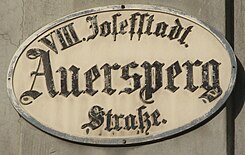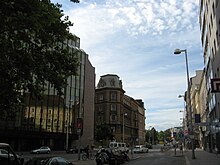Auerspergstrasse
| Auerspergstrasse | |
|---|---|
| Street in Vienna-Josefstadt | |
| Basic data | |
| place | Vienna-Josefstadt |
| District | Josefstadt |
| Created | 1862 |
| Newly designed | 1963 |
| Hist. Names | Am Glacis, Am Paradeplatz |
| Connecting roads | Landesgerichtsstrasse (in the north), Museumstrasse (in the south) |
| Cross streets | Lerchenfelder Strasse, Trautsongasse, Josefsgasse, Josefstädter Strasse (in the west), Doblhoffgasse , Stadiongasse (in the east) |
| Places | Schmerlingplatz |
| Buildings | Auersperg Palace |
| use | |
| User groups | Pedestrian traffic , bicycle traffic , car traffic , underground line U2, tram line 2, 46 |
| Technical specifications | |
| Street length | approx. 280 m |
The Auerspergstraße is located on the border of the two districts of Vienna Inner City and Josef city . It was named in 1862 after the Auersperg Palace located here or after its owners at the time, the Auersperg aristocratic family .
history
The area of today's Auerspergstraße belonged to the unobstructed glacis in front of the Vienna city walls . As a result, the buildings on the street side to today's 8th district formed the front to the suburb. Accordingly, the access road to these houses was called Am Glacis , later Am Paradeplatz , when this part of the glacis was used as a parade and parade ground in the first half of the 19th century. In the course of the razing of the Viennese city wall and the creation of the Vienna Ringstrasse , another ring-shaped street was built on the outside of the former glacis, which was called Cargo Street . As part of this street, it was named Auerspergstraße in 1862 .
location
Auerspergstrasse begins as a continuation of Museumstrasse in the south at Lerchenfelder Strasse and extends in a northerly direction to the level of Josefstädter Strasse or Stadiongasse , where Auerspergstrasse continues in Landesgerichtsstrasse . The northern end of the street is expanded like a square, as Lenaugasse meets Auerspergstraße from the north-west and its continuation in the area of the last block of Auerspergstraße forms its own lane. Between it and the main carriageway of Auerspergstrasse is a small, triangular, unnamed green area. At the southern beginning of Auerspergstraße there is a park on the adjacent Schmerlingplatz . The district border between the 1st and 8th district runs along the eastern side of Auerspergstrasse. Side street in the direction of the Innere Stadt is Doblhoffgasse , in the direction of Josefstadt Josefsgasse and Trautsongasse leave Auerspergstrasse.
traffic
For car traffic, Auerspergstrasse and the adjacent streets form a heavily frequented and important inner-city traffic connection. On both sides of the street there is a well-frequented facility cycle path. Public transport on Auerspergstrasse is well developed. The underground line U2 runs under the street . At the end of Auerspergstraße there is an underground station; at Stadiongasse there is an exit to the Rathaus station , at Schmerlingplatz there used to be an exit to the abandoned Lerchenfelder Strasse station. The underground line goes back to a tunnel of the underground tram that ran here between 1966 and 1980 . Furthermore, tram lines 2 (at Stadiongasse, Josefstädter Strasse) and 46 (at Schmerlingplatz, Lerchenfelder Strasse) cross Auerspergstrasse, with stops at both intersection points.
Building
The buildings on Auerspergstrasse date from different times, starting from the 18th century to the end of the 20th century. On the street side to the 8th district, in contrast to the opposite side, there are business premises. There are residential buildings, event venues, hotels and official buildings on Auerspergstrasse.
No. 1 Palais Auersperg
The Palais Auersperg is on the corner of Lerchenfelder Strasse . In its place there was the Rottenhof (Roter Hof) in the Middle Ages, as the owner of which Wolfgang Kheppler is known to us in 1491. Later owners were Wolfgang Haller von Hallerstein in 1544 and Maria Elisabetha von Rottenau in 1629. This had the so-called Freihof rebuilt in 1644. In 1690 the property belonged to Hyppolitus Marchese von Malaspina, from 1700 to the municipality of Vienna and finally it was acquired by Imperial Count Ferdinand Karl von Weltz in 1708, who combined some properties at this point. Around 1710 he supposedly had a baroque garden palace built by Johann Lucas von Hildebrandt . His heirs sold the palace in 1721 to Hieronymus Marchese Capece di Rofrano, who had Johann Christian Neupauer significantly alter the middle section of the palace. In 1732 the building went to Theresia Countess Kinsky, who around 1760 had Field Marshal Joseph Friedrich von Sachsen-Hildburghausen as a tenant. He appeared as a patron and music lover who, among others, had Christoph Willibald Gluck as a guest here as the conductor of his house concerts. In 1778 the palace belonged to Philipp Graf Kinsky , before it was acquired in 1781 by Prince Johann Adam von Auersperg , whose family it remained for a long time and whose name the building still bears today. He had the palace decorated by Italian artists. Karl von Auersperg had further changes made to the building in 1853. The completion of the renovation work was celebrated in 1856 with a gala dance in which the imperial court took part. 1882–1886 the building got its present appearance through the erection of the wing on Lerchenfelder Strasse and the pillar porch on the central risalit by Gangolf Kayser. After the First World War, the Federal Monuments Office was located in the Auersperg Palace between 1923 and 1935. At the same time, other rooms were used by a film company. In the first months of 1945 the Austrian resistance movement had its seat in the palace. On April 3, 1945, members of the civil and military resistance groups around Carl Szokoll met for a decisive meeting. A memorial plaque reminds of this. During the occupation, the Inter-Allied Military Police had their headquarters here from 1945 to 1955. Bomb damage was repaired in 1953–1954 and Oswald Haerdtl made the last changes to the building. Since then it has been used for various events such as concerts, balls or conferences and has been privately owned since 2006.
No. 2–6 Bartenstein block
The large late historical block of houses in the town hall district between Bartensteingasse , Doblhoffgasse , Auerspergstrasse and Schmerlingplatz was built in 1873–1874 by Josef Hudetz and Moritz Hinträger . It is located at the main address Bartensteingasse 1–5.
No. 3 Beethoven's house
The house at the golden pear was built in the 4th quarter of the 18th century. Ludwig van Beethoven lived here from 1819 to 1820 and the painter Johann Nepomuk Schödlberger died here in 1853. A plaque commemorates the sculptor Josef Thorak , who lived in the house from 1910–1912. The building is at the main address Trautsongasse 2.
No. 5 To the red apple
A house was built here in 1714, which until it was demolished in 1883 housed a well-known folk singer's bar. Among others, Johann Fürst and Josef Matras celebrated their first successes here. Later, however, it sank down to a dive where shady elements mingled with the folk singers, so that the police often had to intervene. From 1837 to 1875 the building belonged to the Schlosser family. Today a late historical house stands in its place.
No. 7 To the little Mariahilf
In 1837 Carl Högl built this Biedermeier house, in the place of which the sculptor Friedrich Wilhelm Stiehle had built a house in 1722 that has since been popularly known as the Sculptor's House . The remarkable classicist facade shows a continuous balcony on the first floor, above a pilaster structure and finally a triangular gable with a relief. The originally four-story house was later extended.
No. 8: Office building
From 1976 to 1980, the City of Vienna's administrative building with its eye-catching glass facade was built according to plans by Harry Glück , Werner Höfer and Tadeusz Spychała . It was located at the main address Rathausstrasse 1 and Stadiongasse 11. Until 2013, the building housed the data center of the City of Vienna; The house was demolished in 2017/2018. The area was previously listed at Landesgerichtsstrasse 2.
No. 9 Former Sanatorium Auersperg
In place of the house to the eye of God , Robert Oerley built a private hospital (Sanatorium Luithlen) from 1907-1908. The building with the simple facade is an interesting example of Viennese modernism . In the 1960s, the roof zone and the interior were changed and the building has since been used as a student residence.
No. 11 To the city of Belgrade
The house, built by Alois Ignaz Güll in 1837, once housed a well-known inn owned by Josef Klampfl, which was frequented by numerous musicians in the pre- March period . The house is at the main address Josefsgasse 1.
No. 13 With the blacksmiths
The pre-March community center was built by Karl Ehmann in 1828. It has a classicist facade with a column portal, mask and a balcony above. While the canopies on the first floor are just closing, the windows on the second floor have lunettes with reliefs depicting medallions on the head, staffs of Aesculapia and lyre. In the inner courtyard there are pawlats with columns and pillars.
No. 19 To the Golden Lamb
The house was built in 1762 and received its balcony veranda on the first floor by Franz Reumann in 1848. In the foyer of the building you can see paintings with putti allegories and a plaster figure of a faun playing Tschinellen at the top of the stairs. The house has housed a basement stage since the 1960s, in which many well-known cabaret artists have performed since then. First, Der Bunte Wagen played here , whose members switched to the Simpl cabaret in 1974 . Then the stage was called Theater beim Auersperg , which offered a diverse program, from avant-garde theater plays to concerts. After its bankruptcy in 2001, the stage has been used by the cabaret nettles since 2003 .
literature
- Felix Czeike : Viennese district culture guide Josefstadt . Jugend & Volk, Vienna 1980, ISBN 3-7141-0489-5 .
- Felix Czeike (Ed.): Auerspergstrasse. In: Historisches Lexikon Wien . Volume 1, Kremayr & Scheriau, Vienna 1992, ISBN 3-218-00543-4 , p. 185 ( digitized version ).
- Federal Monuments Office : Dehio-Handbuch Wien. II. To IX. and XX. District . Anton Schroll, Vienna 1993, ISBN 3-7031-0680-8 .
Web links
Individual evidence
- ↑ wienerzeitung.at ( Memento of the original from February 23, 2014 in the Internet Archive ) Info: The archive link was inserted automatically and has not yet been checked. Please check the original and archive link according to the instructions and then remove this notice. dated December 11, 2013, accessed February 11, 2914
Coordinates: 48 ° 12 ′ 29 " N , 16 ° 21 ′ 18.9" E







